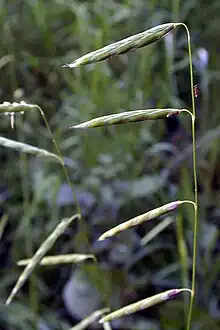| Pleuropogon hooverianus | |
|---|---|
 | |
| Scientific classification | |
| Kingdom: | Plantae |
| Clade: | Tracheophytes |
| Clade: | Angiosperms |
| Clade: | Monocots |
| Clade: | Commelinids |
| Order: | Poales |
| Family: | Poaceae |
| Subfamily: | Pooideae |
| Genus: | Pleuropogon |
| Species: | P. hooverianus |
| Binomial name | |
| Pleuropogon hooverianus (L.D.Benson) J.T.Howell | |
Pleuropogon hooverianus is a rare species of grass known by the common name North Coast semaphoregrass. It is endemic to northern California, where it is known from Mendocino, Marin, and Sonoma Counties. It grows in moist marshy areas and shady redwood forests. It is an erect perennial grass growing to a maximum height between one and 1.6 meters. The inflorescence bears widely spaced narrowly cylindrical spikelets which hang sideways off the stem, resembling semaphore signals. Each spikelet may be up to 4.5 centimeters long and may contain up to 16 flowers.
References
External links
This article is issued from Wikipedia. The text is licensed under Creative Commons - Attribution - Sharealike. Additional terms may apply for the media files.
